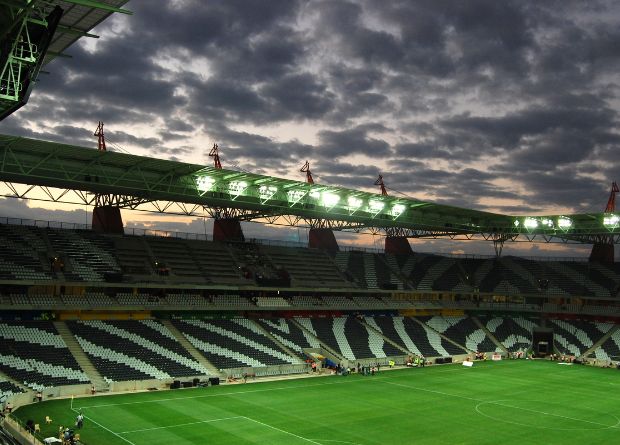Mbombela Stadium, located in the Mpumalanga province of South Africa, is a state-of-the-art sports facility that was constructed for the 2010 FIFA World Cup. With a seating capacity of 43,500, it is one of the five newly constructed stadiums for the tournament. The stadium is home to the Pumas, a South African rugby team, and has hosted several international matches and other sporting events.

The architectural design of Mbombela Stadium is unique and impressive. The stadium features 18 majestic orange giraffe columns that support the roof structure and black and white zebra skin patterned seating. The bright colors of the stadium create a vibrant and friendly atmosphere. The stadium has a draped corrugated metal ceiling that protects the smaller structural members from nesting and roosting. The larger members, designed for the maximum size that could be locally rolled by Iscor, are too large for avian comfort.
Key Takeaways
- Mbombela Stadium is a state-of-the-art sports facility located in the Mpumalanga province of South Africa.
- The stadium features a unique architectural design, including 18 orange giraffe columns and black and white zebra skin patterned seating.
- The stadium’s corrugated metal ceiling protects the smaller structural members from nesting and roosting while the larger members are too large for avian comfort.
Architectural Design

Mbombela Stadium is a prominent architectural landmark that adds a sculptural essence to the city’s skyline. The stadium’s unique design and roof structure frames the stunning views of the surrounding mountains, offering spectators an immersive and breathtaking experience.
Stadium Layout
The stadium has a unique layout that maximizes spectator comfort and the viewing experience. The stadium has a seating capacity of 40,929, and 94% of the seats are under the roof, ensuring that spectators are protected from the elements. The stadium’s seating arrangement is designed to provide an unobstructed view of the field, and the seats are arranged in a steep angle to ensure that spectators are close to the action.
Facade and Exterior
The exterior of the stadium is designed to reflect its inter-relation with the nearby Kruger National Park. The signature feature of the stadium is the 18 roof supports that resemble giraffes. The seats are patterned with zebra stripes, adding to the stadium’s unique design. The stadium’s facade is made of a combination of brick, steel, and glass, giving it a modern and sleek appearance.
Overall, the architectural design of Mbombela Stadium is a testament to the creativity and innovation of the architects and designers involved in its construction. The stadium’s unique design and layout have made it a landmark in the city, and it continues to attract visitors from all over the world.
Also, check: Loftus Versfeld Stadium: A Comprehensive Guide to Pretoria’s Iconic Venue
Engineering and Construction

Foundation and Structure
Mbombela Stadium is a world-class facility located in Nelspruit, South Africa. Construction of the stadium began in February 2007 and was completed in November 2009. The stadium’s foundation consists of 1,500 piles on a 10m structural grid, providing a solid base for the structure. The piles were driven into the ground to a depth of 18m, ensuring stability and safety. The stadium’s foundation and structure were designed to withstand seismic activity and extreme weather conditions.
Roofing System
The roofing system of Mbombela Stadium features 18 majestic orange giraffe columns that support the roof structure. The roofing system was designed to provide ease and safety of construction. Every element of the roof is light enough to be lifted using conventional cranes, making the construction process more efficient. The rectangular shape of the stadium provides the best view of the pitch, ensuring that spectators have an uninterrupted view of the game.
Materials and Sustainability
Mbombela Stadium incorporates world-class facilities and materials. A total of 45,000m3 of concrete was used in the construction of the stadium, and the 36m cantilever steel roof weighs 1,450 tons. The stadium’s seating capacity is 43,500, and the black and white zebra skin patterned seating adds a unique touch to the stadium’s design. The bright colors of the stadium create a vibrant and friendly atmosphere.
The stadium’s construction was designed with sustainability in mind. The roofing system allows for natural ventilation, reducing the need for air conditioning. The stadium also features a rainwater harvesting system, which collects rainwater for use in the stadium’s toilets and irrigation system. The stadium’s sustainable design has earned it a four-star rating from the Green Building Council of South Africa.
Mbombela Stadium is a testament to the power of engineering and construction. The stadium’s foundation, roofing system, and materials were all carefully designed and constructed to ensure safety, efficiency, and sustainability.
Also, check: Inside Ellis Park Stadium: A Comprehensive Tour of Johannesburg’s Iconic Venue
Location
Frequently Asked Questions
What are the distinctive architectural features of Mbombela Stadium?
Mbombela Stadium is known for its distinctive architectural features, including 18 orange giraffe-shaped columns that support the roof structure, and black and white zebra skin patterned seating. The stadium has a seating capacity of 43,500 and is one of the five newly constructed stadiums for the 2010 FIFA World Cup.
How does the design of Mbombela Stadium reflect its surrounding environment?
The design of Mbombela Stadium reflects the surrounding environment, particularly the nearby Kruger National Park. The stadium’s orange giraffe-shaped columns and black and white zebra skin patterned seating are inspired by the wildlife that can be found in the park.
What were the major engineering challenges faced during the construction of Mbombela Stadium?
One of the major engineering challenges faced during the construction of Mbombela Stadium was the construction of the roof. The roof is supported by 18 giraffe-shaped columns, each of which weighs 80 tons. The roof structure itself weighs 3,500 tons and is made up of 36 steel trusses.
What materials were used in the construction of Mbombela Stadium?
The construction of Mbombela Stadium involved the use of a variety of materials, including steel, concrete, and glass. The orange giraffe-shaped columns that support the roof structure are made of steel, while the seating is made of concrete. The stadium’s façade is made up of glass panels.
How has Mbombela Stadium been designed to accommodate a variety of events?
Mbombela Stadium has been designed to accommodate a variety of events, including football matches, rugby matches, and concerts. The stadium has a flexible seating configuration that can be adjusted to suit different events. The stadium also has a variety of hospitality suites and conference facilities.
What are the sustainability features incorporated into the design of Mbombela Stadium?
Mbombela Stadium incorporates a number of sustainability features, including rainwater harvesting systems, energy-efficient lighting, and natural ventilation systems. The stadium also has a waste management system in place to ensure that waste is recycled or disposed of responsibly.



